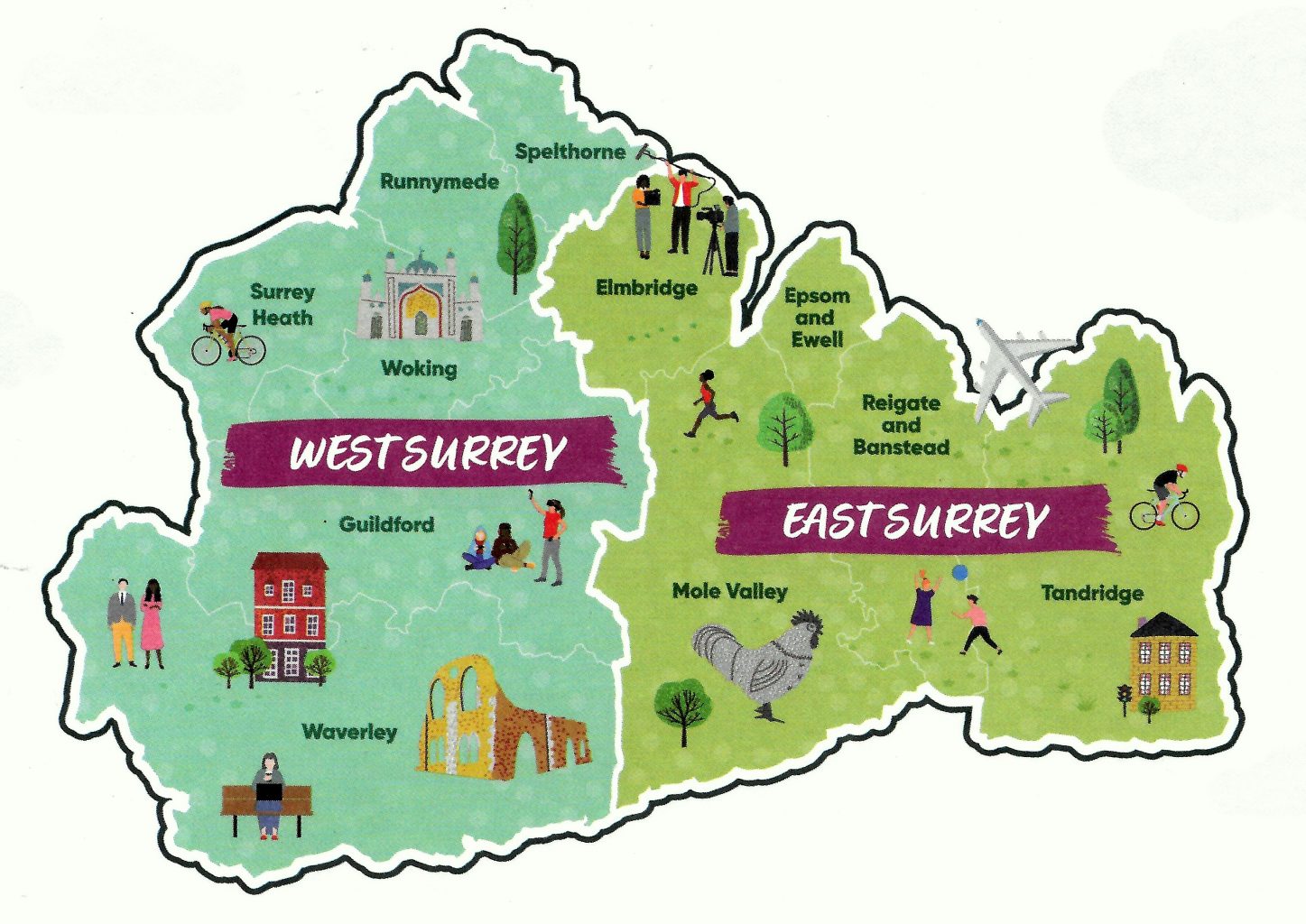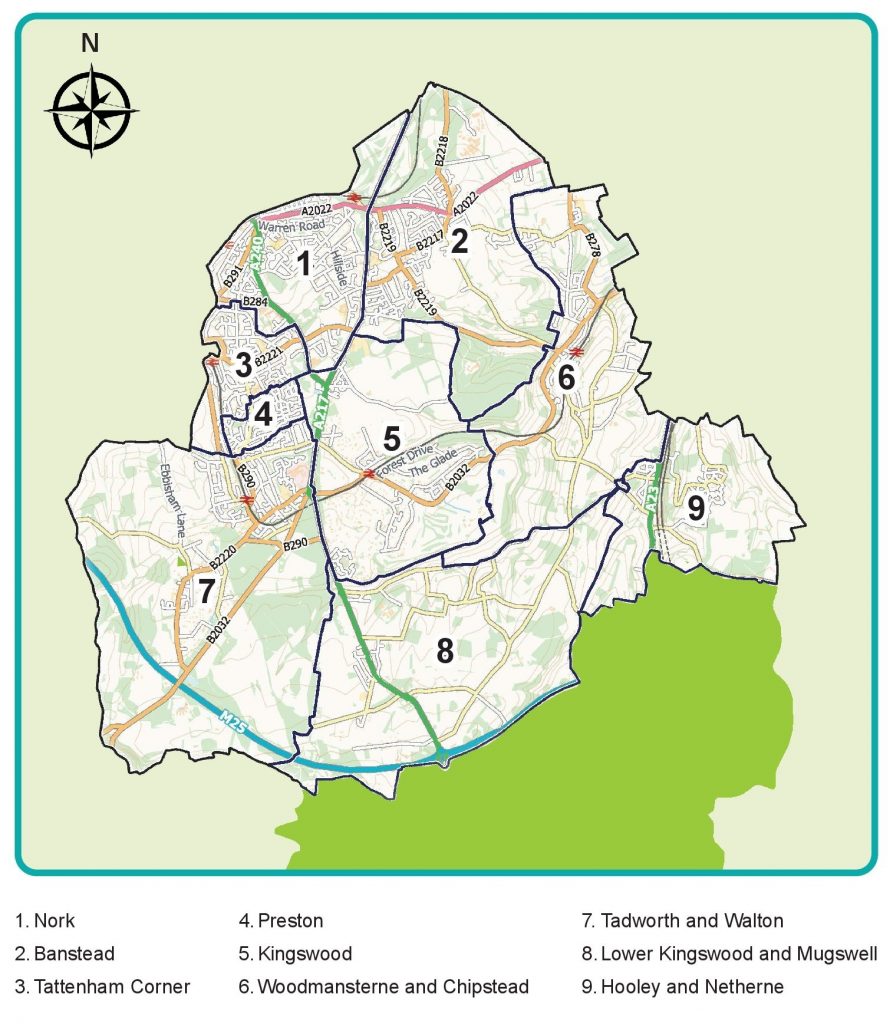Local Government Reorganisation and Devolution
The Govenment has decided that there will be only two new unitary councils in Surrey, despite a clear majority of all responses to the consultation – from the public, businesses, voluntary groups, councillors and councils themselves – favouring the three unitary option. So there will be no North Surrey, just East and West, with Elmbridge (Walton, Weybridge, Molesey, Esher and Cobham) joining Epsom & Ewell, Mole Valley, Tandridge – and Reigate & Banstead in East Surrey.
The Minister said that both the two and three unitary options meet their criteria of the new councils being “right-sized for efficiencies, improved capacity and ability to withstand financial shocks and delivery of high quality public services etc”. The Minister went on to say that he ruled in favour of the two unitaries on financial grounds “in the unique context of Surrey where reorganisation is a critical intervention to improve financial viability”. He is talking about Woking, and to a lesser extent Spelthorne and Runnymede, which have significant debts. In Woking’s case, he committed the Treasury to writing off £500 million of Woking’s unsupported debts of over £2 billion, which he highlighted as “significant and unprecedented”.

No doubt other councils around the country will be lining up with their begging bowls – as a reminder we in Reigate & Banstead have no borrowings whatsoever. However, in truth, the Minister had little option, as the new West Surrey Council would have gone immediately into bankruptcy without this write off.
Next year, in May 2026, there will be elections to the new East Surrey Council. That new council will operate in “shadow” form, appointing its new leader, chief executive and senior officers and getting ready to take over on 1 April 2027.
Until that day, Surrey County Council and Reigate & Banstead Borough Council continue to be fully responsible for all our services. Clearly a lot of work has started to look how services in the boroughs can be joined together and look for savings. And conversely, at the county level on how to separate the current combined services. As the county spends six times as much as the boroughs, there will be a lot of work trying to ensure the system doesn’t become less efficient and more costly.
It had been expected that elections for an overall elected mayor in Surrey would be held in May 2027. The Government has squashed that notion as they are too busy reorganising the remaining shire councils. This mayor (unlike the civic mayors we currently have) would have similar powers to Mayor Khan in London. Responsibilities would include running the police and fire service, overall transport and planning responsibilities and economic regeneration. This is disappointing in particular for Cllr Tim Oliver who had his eyes on a pot of redevelopment funding from government and this had led him to volunteer for early reorganisation of local government in Surrey. There is now no fixed date for mayoral elections.
A local government expert from the London School of Economics has said that the benefits case for this reorganisation is unproven, but the result will be to facilitate planning and growth. The new council will serve well over half a million people. He pointed out there will be a very low number of councillors and local representation per head of population which will lead to “one of the most democratically unrepresented areas in Europe.”
Local representation will shrink from seven councillors to two. The wards for the new council will be based on the current electoral boundaries for county council elections. There will be two councillors elected for the Nork and Tattenhams area, but the Preston part of our area (south of Chetwode Road) will be aligned with Tadworth, Walton & Kingswood, where there will also be two councillors.
The government continues to call its new arrangements as devolution, when it seems to in fact be moving in the opposite direction – moving decision making upwards to larger bodies. One of the government’s stated aims in the reorganisation
is to “enable stronger community engagement and deliver genuine opportunity for neighbourhood empowerment.” It is to take advantage of such opportunities that the councils in East Surrey are offering the possibility of local councils (parish and town) compensating for the emerging democratic deficit.
Banstead and The Villages Council
What is a Local Council?
Local Councils are often known as Town or Parish Councils and operate with elected volunteer, unpaid councillors. There are already 85 such councils in Surrey, mainly in the rural south; in Reigate & Banstead we have a Town Council in Horley and a Parish Council in Salfords & Sidlow. Local Councils are now being proposed across most of the towns and suburban areas closer to London – for example in Epsom & Ewell and Mole Valley. There have been similar moves In other counties – for example in Cornwall and Somerset – which are already unitaries.
Town Councils and Parish Councils – collectively Local Councils – are effectively all the same and different in name only. They have the same powers. Town Councils tend to operate in urban areas and have larger populations; they may have a town mayor too. Parish Councils tend to operate in rural areas and have a smaller population. Parish Councils are civil councils and completely different from a church parish.
Proposal
It is proposed to set up a Local Council north of the M25 to be known as “Banstead and The Villages Council”. Besides our ward it would include Banstead Village itself plus Tadworth, Walton, Kingswood, Chipstead etc. and would have 40,000 electors. Smaller parish councils for individual wards have been rejected as too small to be effective and would be relatively costly per head to run.

What does a Local Council do?
- A Local Council could be important in development and planning applications, ensuring focus is given to the new grey belt designation of our countryside. It could make well thought through representations to the planning department of the unitary council as the powers of individual councillors on planning committees are expected to reduce, operating in an environment where housing targets are being more than doubled.
- Local Councils can improve the quality of life, often providing “first level” truly local services, such as community halls, allotments, playgrounds, parks, pavilions and more. They can help argue for and protect services which the new unitary council might consider reducing or removing altogether.
- A Local Council has a statutory right to 15% of the Community Infrastructure Levy (CIL) charged on all new development. This “Local CIL” could be used to pay for local initiatives.
Of course all this has to be paid for, and any additional council tax levy would have to be very carefully considered. In Horley there is a refund agreement with Reigate & Banstead to pay for some services, avoiding double taxation. As a comparison the annual Band D equivalent charge for Salfords & Sidlow is £33 and for Horley (which has a wider range of services) is £55. The cost for us would depend on the services residents want the Council to provide.
Borough and County Councillor Peter Harp recently posted on social media this quick summary of the Parish/Town discussion.
“Reigate and Banstead Borough Council are currently consulting residents about whether they would like a parish/town council to cover essentially the part of RBBC north of the M25, effectively the old Banstead Urban District Council area. The precise name and area are also being consulted on with the suggestion being “Banstead and The Villages Council”. RBBC, and several other district councils in Surrey, such as Epsom & Ewell, believe this will address the likely democratic deficit and provide more local knowledge to help assist the incoming East Surrey Council that will be replacing both Surrey County Council and Reigate and Banstead Borough Council in our area. Parish/town councils already exist widely across Surrey and our area might lose influence without one.
Naturally one of residents’ concerns is the potential cost. Based on the nearest existing parish/town councils (Horley, Salfords & Sidlow) this is likely to be between £10-£55 per year per household but an exact amount can’t be stated at this stage BECAUSE it will depend on what services and responsibilities the local residents want their new parish council to provide and manage.
Horley Town Council has lasted a century and clearly their residents believe the extra relatively small cost is worthwhile as they would have voted to abolish the council if they were unhappy with it. So, if a local parish council is created, it’s up to the local residents served by it to decide what it should do (Allotments are the only statutory responsibility – Horley manages all their parks and recreation grounds for example) and therefore how much it will cost residents.
Ultimately IT’S UP TO YOU. Elsewhere residents do like their parish councils and the town/parish council environment will give you the opportunity to vote for LOCAL councillors who you will be able to discuss local issues with.”
